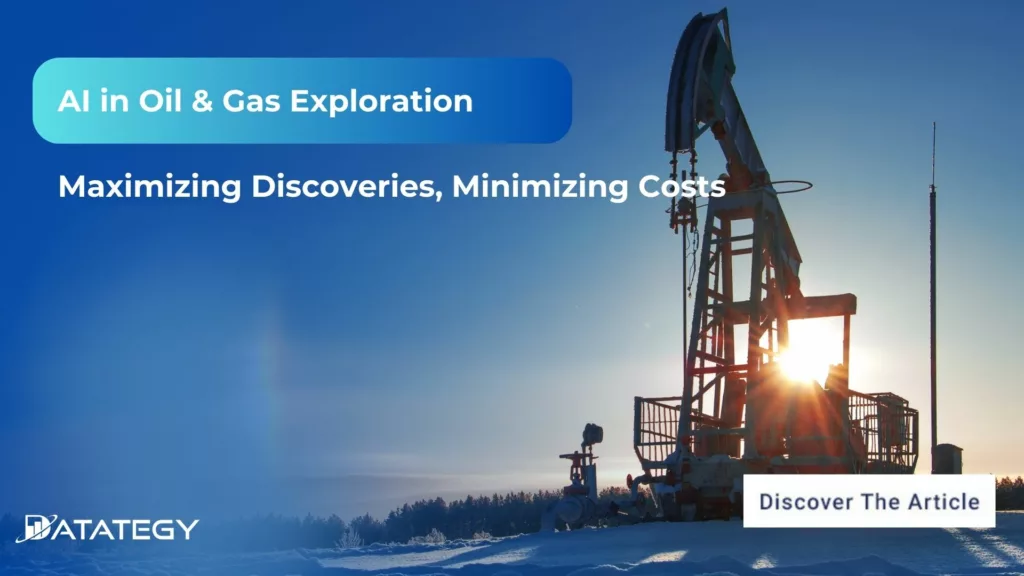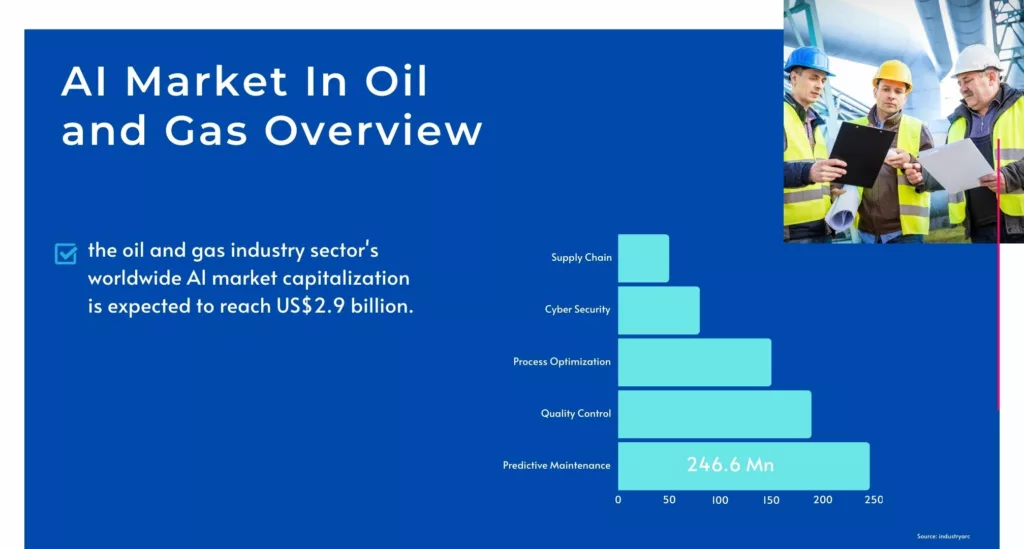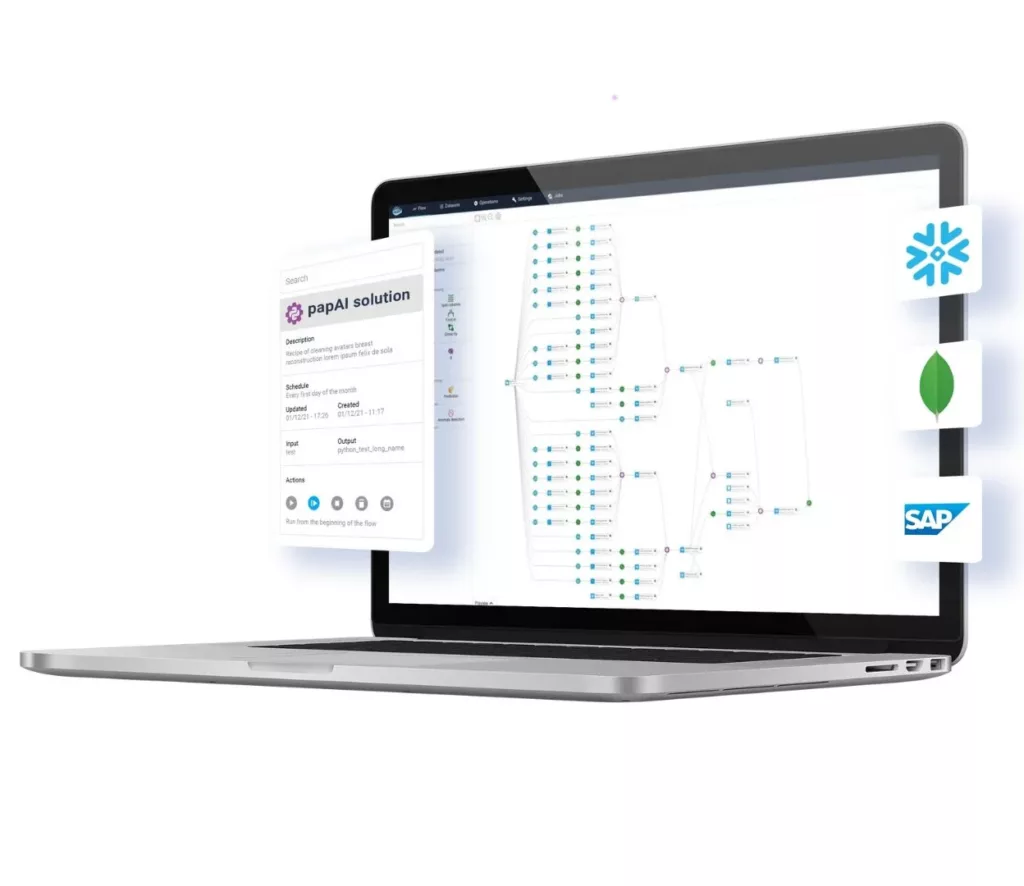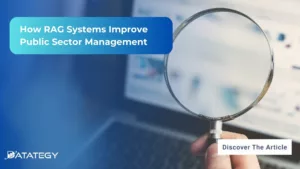How Law Firms Use RAG to Boost Legal Research RAG...
Read MoreAI in Oil & Gas Exploration:
Maximizing Discoveries, Minimizing Costs
Table of Contents
ToggleIn the oil and gas industry, exploring for resources is important but can be time-consuming and expensive. Artificial intelligence is a helpful technology that can make this process more efficient, accurate, and safe. A recent study by Grand View Research, found that by 2023, 60% of oil and gas companies want to use artificial intelligence for exploration.
Find out how papAI can improve the deployment of AI projects in the Oil and Gas Industry.

In this article, we’ll look at the role of AI in oil and gas exploration, its benefits, the challenges it presents, and how companies can drive its adoption.
What does AI in Oil and Gas Exploration Mean?
Using artificial intelligence (AI) in oil and gas exploration means utilizing cutting-edge technology and machine learning algorithms to evaluate enormous datasets, decipher difficult geological data, and streamline operational procedures. In this sense, artificial intelligence (AI) facilitates predictive modeling, improves decision-making, and adds automation, which in turn maximizes findings, reduces expenses, and transforms conventional exploration techniques.
Importance of Increasing Discoveries and Reducing Expenses in the Current Energy Environment
It is impossible to overestimate the importance of using effective exploration techniques to maximize finds and minimize costs in the current energy environment. The constant increase in the world’s energy consumption makes the search for new, sustainable supplies necessary. By maximizing finds, the sector can assist economic development and fulfill the expanding energy demands of a growing population.
Information on the Oil and Gas industry's AI market
The global AI market’s oil and gas sector is projected to hit $2.9 billion by 2030. In 2022, nearly 30.2% of the market was dominated by the predictive maintenance category.
The services category accounted for more than 41.4% of the market share, while the upstream oil and gas industry had a value share exceeding 51.8%.
North America, with over 38% of the global market, held a substantial share in the AI for oil and gas industry. However, the Asia Pacific market is expected to expand at the highest pace, with a CAGR of 17.4%.

What are The Benefits of Using AI in Oil and Gas Exploration
Proactive risk management:
In the context of oil and gas development, proactive risk management is a strategic need that involves anticipating and reducing any hazards before they materialize.
By using sophisticated analytics and predictive modeling, AI technologies are essential to this proactive strategy.
Artificial Intelligence has the ability to recognize and evaluate risks associated with environmental conditions, equipment malfunctions, and geopolitical uncertainty by examining historical data, market patterns, and operational characteristics. Exploration teams may take proactive steps to ensure operational safety, regulatory compliance, and asset protection thanks to this foresight.
Automation and Operational Efficiency:
Using artificial intelligence (AI) for real-time monitoring and decision-making is central to the centric approach to operational efficiency. The technology gives exploration teams access to a constant flow of data, allowing them to act quickly and decisively. Through the utilization of AI’s quick data analysis and pattern recognition capabilities, oil and gas firms may enhance their decision-making procedures.
This improves overall operational agility and facilitates quick modifications to factors such as resource allocations or drilling settings, keeping exploratory efforts optimized and responsive to demands in real-time.
To put it simply, operational efficiency and automation—which are fueled by an AI integration strategy that is centric—revolutionize the way the industry conducts and performs exploration work, paving the way for a future that is marked by accuracy, speed, and flexibility.
Effective Resource Allocation:
In oil and gas exploration, cost-effective resource allocation is a key element of lucrative and sustainable operations. AI evaluates historical data, and market trends.
With the use of technology, resource utilization patterns may be thoroughly understood, allowing exploration teams to decide where to spend to get the best returns. AI greatly helps to reduce wasteful spending and maximize returns on investment by determining the most promising areas for investigation and effectively allocating resources. The industry’s goal of achieving financial sustainability and competitiveness in a dynamic market context is in line with this resource allocation strategy.
Demystifying AI: A Comprehensive Guide to Key Concepts and Terminology
This guide will cover the essential terminology that every beginner needs to know. Whether you are a student, a business owner, or simply someone who is interested in AI, this guide will provide you with a solid foundation in AI terminology to help you better understand this exciting field.

AI Use Cases in the Real World
There are many specific AI use cases in exploration that exemplify the technology’s capacity to enhance precision, efficiency, and decision-making throughout the critical phases of oil and gas exploration.
Prospect Ranking and Prioritization:
AI-powered prospect ranking and prioritization transforms the conventional wisdom surrounding oil and gas exploration by presenting a data-driven approach to pinpointing high-potential locations. A wide range of geological and geophysical data are analyzed using machine learning algorithms, which take into account variables including seismic characteristics, rock structures, and past exploration results.
AI helps exploration teams quantify each possibility by identifying complex patterns in the data, which allows for a methodical rating of prospects according to their likelihood of yielding hydrocarbon finds. By directing exploratory efforts towards places with the best chance of success and reducing the risk of allocating resources to less promising sites, this dynamic strategy optimizes decision-making.
Drilling Target Optimization:
AI-powered drilling target optimization is a new way to improve drilling accuracy and success. It uses machine learning algorithms to analyze subsurface data like geological formations, seismic characteristics, and past drilling results. This helps choose the best drilling targets for oil and gas exploration.
Large-scale information is processed by machine learning algorithms, which then look for patterns and correlations that might point to possible hydrocarbon sources. Exploration teams may reduce the risk of drilling dry wells and maximize overall exploration success by proactively selecting drilling locations with a better possibility of striking large hydrocarbon resources by utilizing these findings.
Real-time Well Placement:
The potential of real-time well placement to reduce drilling hazards and maximize reservoir recovery makes it significant. Through the utilization of AI’s quick data processing and pattern recognition skills, exploration teams may react quickly to unforeseen obstacles like shifting subsurface conditions or geological abnormalities.
This flexibility ensures ideal well trajectories that cross important reservoir zones, which not only reduces the possibility of expensive drilling mistakes but also helps with the effective recovery of hydrocarbons.
Satellite Image Analysis for Surface Geology:
Using artificial intelligence, Satellite Image Analysis for Surface Geology delves into the interpretation and analysis of extensive satellite images, offering priceless insights into surface geological characteristics.
AI systems that have been trained on large datasets are able to recognize and categorize different geological formations, kinds of land cover, and topographical changes that are apparent from space. Before devoting more resources to resource-intensive subsurface studies, this study provides a basic knowledge of surface conditions and geological formations, which helps exploration teams decide whether places are suitable for more exploratory efforts.
Predictive Maintenance for Equipment:
In the realm of oil and gas exploration, the application of artificial intelligence for predictive maintenance of equipment is a transformative innovation that is reshaping how the industry cares for and controls its crucial assets.
By employing AI algorithms, exploration companies can foresee potential equipment malfunctions and failures before they occur, facilitating proactive and timely upkeep.
These algorithms provide a more accurate and effective method than typical planned maintenance by analyzing sensor readings, previous equipment performance data, and other pertinent information to find patterns suggestive of approaching problems.
Create your Custom AI tool to Improve your Oil & Gas Exploration Process with papAI
Use papAI’s potential to address exploration issues in the field of artificial intelligence for oil and gas exploration. The need to develop AI-powered solutions grows as the demand for energy continues to rise. With papAI’s skill in managing large datasets and its expertise in pattern recognition analysis, you may enable your company to make educated decisions, develop long-term risk management plans, cut costs, and strengthen overall operational resilience.
Schedule a demo today to discover the benefits of papAI. To experience papAI’s benefits, schedule a demo right away. You will receive assistance from our experts in integrating AI into your risk management initiatives. This ensures a cutting-edge approach tailored to the unique challenges of the oil and gas sector.

Using artificial intelligence (AI) in oil and gas exploration means utilising cutting-edge technology and machine learning algorithms to evaluate enormous datasets, decipher difficult geological data, and streamline operational procedures.
Proactive risk management, Automation, and Operational Efficiency and Effective Resource Allocation are the main benefits of using AI in oil and gas exploration.
There are many specific AI use cases in the exploration field:
- Prospect Ranking and Prioritization.
- Drilling Target Optimization.
- Real-time Well Placement.
- Satellite Image Analysis for Surface Geology.
- Predictive Maintenance for Equipment.
Interested in discovering papAI?
Our AI expert team is at your disposal for any questions
How RAG Systems Improve Public Sector Management
How RAG Systems Improve Public Sector Management The most important...
Read MoreScaling RAG Systems in Financial Organizations
Scaling RAG Systems in Financial Organizations Artificial intelligence has emerged...
Read MoreHow AgenticAI is Transforming Sales and Marketing Strategies
How AgenticAI is Transforming Sales and Marketing Strategies Agentic AI...
Read More


